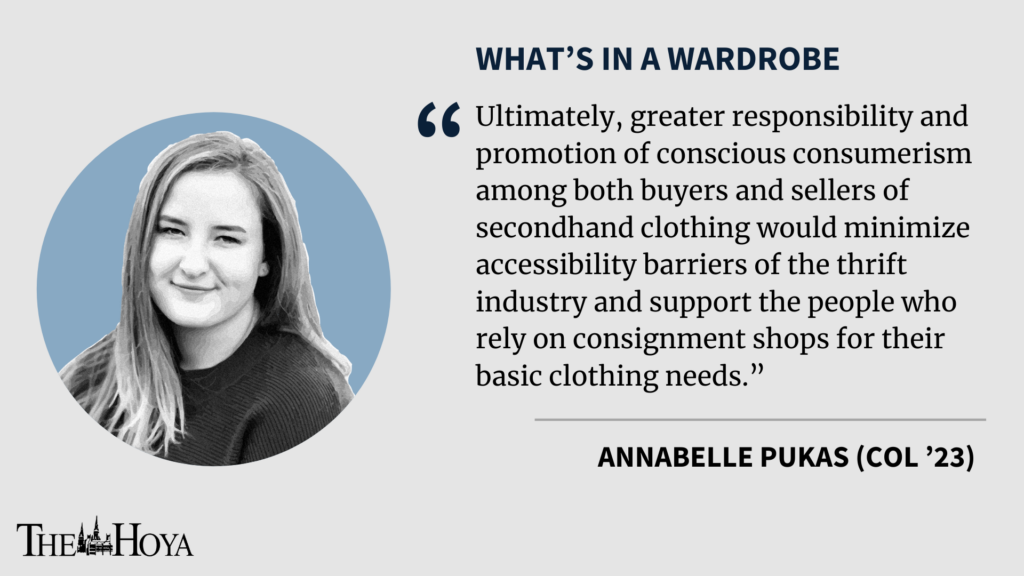Thrift stores have become an increasingly important facet of the clothing industry, expected to reach $28 billion in revenue by 2024. The rise in thrift stores’ popularity has saturated the market with buyers and raised a new concern about the industry becoming increasingly gentrified.
Advocates against middle-class thrifters and resellers argue that this rise in consumption snatches good-quality, affordable clothing out of the hands of low-income shoppers who desperately need it. However, this access disparity does not have to be the case. Both thrift stores and consumers have formidable influence over the life cycles of existing clothing items, and conscious participation in the secondhand clothing industry could ensure affordable clothes are accessible to everyone.
Thrift store gentrification typically refers to the exclusion of low-income people from shopping secondhand when there is an influx of privileged people who consume the items that are available in stores. While this process has begun to occur in locations across the country, there is a way thrift stores can actually address the problems of gentrification while keeping their profits high, clothes affordable and the environment clean. Consignment stores can achieve these goals by moving more inventory through their locations rather than selling it abroad for profit.
Currently, less than 10% of the clothing donated to thrift stores is sold to domestic consumers. The other 90% is primarily sent to landfills, incinerated, shipped abroad to foreign textile markets or repurposed. Secondhand shops could increase profit if they were less selective about what items they put up for sale while widening access to affordable clothing pieces and diverting these items away from becoming waste.
Keeping sales localized to American consumers also affects the international clothing industry and the environment. Discarded clothes are shipped by the boatload to developing nations, which can inhibit these countries’ traditional clothing production and local commerce. Selling additional stock in local secondhand stores avoids this new form of colonialism and creates the opportunity for more organic economic growth in these locations. Furthermore, creating this circular clothing system in the American secondhand market minimizes the carbon footprint of shipping mass amounts of clothing across borders.
Beyond the potential changes to thrift store inventory management, consumers have many opportunities to create a more sustainable and accessible secondhand industry, primarily by throwing away less clothing. On average, each American discards around 80 pounds of clothing annually and many of these items require hundreds of years to break down in a landfill. Collectively, this wastefulness results in 26 billion pounds of textiles entering landfills each year and $88 billion in product value and resource losses. Not only is this practice economically irresponsible and environmentally detrimental, but it also limits the amount of clothing people with lower incomes have access to since usable items are ending up as waste.
Americans should also be more considerate about the end-of-life of their clothing pieces and donate only gently used, good-quality items to thrift stores or sell their pieces on sites like eBay or Depop. Giving a garment a second life through either of these channels reduces that item’s carbon emissions by 79%.
For pieces that are unlikely to be purchased, people can either repair them or drop them off at domestic textile recycling locations such as the ones hosted by the American Textile Recycling Service. These programs evaluate the donated fabric and repurpose the materials in a responsible way. This thoughtfulness in regard to the life cycle of clothing items helps reduce the burden on thrift stores to discard an excess amount of clothing and fosters a sense of accountability within the clothing industry overall.
Ultimately, greater responsibility and promotion of conscious consumerism among both buyers and sellers of secondhand clothing would minimize accessibility barriers of the thrift industry and support the people who rely on consignment shops for their basic clothing needs. Thrift store gentrification is not the inevitable end to a secondhand economy. Modifications to the current handling of donated items and active participation of consumers are vital for promoting a socially and environmentally responsible secondhand clothing market.
Annabelle Pukas is a sophomore in the College. What’s in a Wardrobe appears online every other Thursday.









